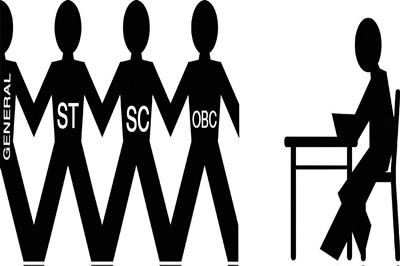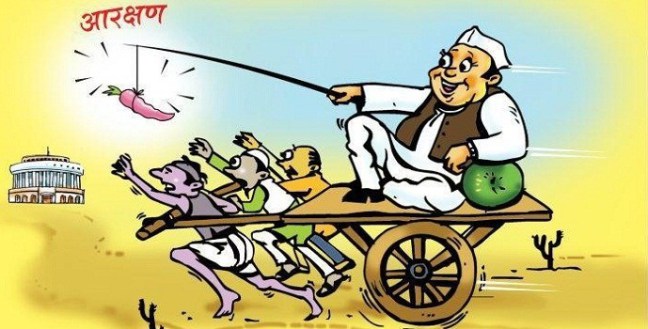I earn my living as a senior education administrator and I have been doing this for the past five years. I want to declare here that the education sector of this country is at a very critical stage due to Reservation.
Unfortunately, I am a Bengali Brahmin by birth and so, I belong to the general category students in this country. But I am not prejudiced against any caste or religion, rather I will try to present my arguments based on facts.
None of you have actually realised what has happened to the education system of this country while you were not looking.
Here is what has happened.

The general education policy of India is usually prescribed by the government (both at the Centre and at the states) for colleges and institutions that are funded by them, partially or wholly.
Most private colleges or educational institutes don’t have reservation since they don’t receive money from the government as aid.
Since education is a Concurrent Subject under the Indian constitution, both the Centre and the State government may have their own legislations and jurisdictions over it.
This is where the problem begun and look where it has reached now.
Let’s look at how the different governments have dealt with Reservation in Educational institutes that includes technical institutes like the IIT and specialised professional institutes like Medical Colleges.
Many years back, the norm was 22.5 per cent reservation in educational institutes for ST, SC, OBC and other backward classes as per the Central government policy.
That system came under heavy artillery fire because the general category people argued that the reservation percentage was too high and that the general category students were being discriminated against.
The Central government initially agreed and started looking for a solution.
The governments (The Congress government at the Centre and others at the states) formed Committees, Advisory Bodies, Peer Groups to look into the criticism and finally, came back with a marvellous solution.
The solution was an increase in the reservation to 49.5%!
This meant close to half of the seats of central government funded educational institutes were reserved for students who might otherwise not qualify for admissions in the first place.
You might ask me, why not 50% reservation?
It is because there is a Supreme Court ruling that half of the seats in a college or a professional institute cannot be reserved.
It has to be less than that.
Nobody imagined at that time that the Congress government at the Centre would raise the cap which is just half a per cent point short from the prescribed upper limit set by the Supreme Court of India.
Some political parties in the states which play vote-bank politics (this means they expressly ask for votes on basis of religion, caste and creed) were obviously not happy with this 50% limitation imposed on them by the Supreme Court.
So, what did they do?
A few state governments again came back with another brilliant solution!
Some of them blatantly disregarded the Supreme Court order to impose more than 50 per cent reservation in schools, colleges and technical institutes in their respective states.
Currently , there are five states in India which has more than 50 per cent reservation. The states are:
- Tamil Nadu: Reservation is up to 69 per cent (SC-18 per cent, ST-one per cent, OBC-50 per cent)
- Telengana: The state currently has 62 percent reservation.
- Maharashtra: On 25 June 2014, the erstwhile Congress-NCP government had approved 16 per cent reservation for Marathas and 5 per cent for Muslims in government jobs and educational institutions, over and above the 49%. But the Bombay High Court put it on hold, saying the reservation ceiling cannot exceed 50 per cent, except in extraordinary situations and for extraordinary reasons. In the case of public employment, 52 per cent reservation is in place for backward classes under a 2001 State Reservation Act.
- Haryana: The Haryana Backward Classes (reservation in services and admission in educational institutions) Act, 2016, passed on 26 May 2016, gave 10 per cent reservation to Jats and five other communities, including Jat Sikhs, Muslim Jats, Bishnois, Rors, and Tyagis, under the special backward class category. It has given another 10 per cent reservation to economically backward persons from the general category, which took the total reservation to 67 per cent, exceeding the SC-imposed cap.
- Rajasthan: The Rajasthan Backward Classes (Reservation of Seats in Educational Institutions in the State and of Appointment and Posts in Services under the State) Bill, 2017, proposes a five per cent increase in the OBC quota. The bill raises reservation for Gujjars and four other backward communities in Rajasthan from 21 per cent to 26 per cent. With this new 5 per cent category, reservation in the state now stands at 54 per cent – above the 50 per cent legal cap. (Source)
How does this help the political parties?
If you go and attend their rallies, you will see that the leaders organise political meetings at areas where the reserved category people are dominant and ask for votes because they have provided reservations for them in schools, colleges and government jobs.
The claim of these political leaders are very simple: “I have made it easier for you to get admission in top schools, colleges and get a government job, so… vote for me”.
The worst part is, they are getting votes and winning elections on the basis of those claims. So more and more politicians are taking that route to secure a vote bank for themselves.
This has given rise to a different kind of culture: India has seen the rapid rise of class struggles from categories or castes that were not included in the list of ST, SC and OBC. Some of them are even resorting to violence to get what they want.
The castes that are still not included in the reservation list are demanding more reservation and they are organising rallies, calling for strikes and even resorting to violence when the government is not listening to them.
Currently, there are five major castes in India who are demanding reservations for them. Some of protests have even resulted in death.
Some of the political parties have even made this a part of their election manifestos.
The political party which has promised the maximum number of reservations and made it into a political manifesto ahead of election is Karnataka Chief Minister Siddaramaiah of the Congress party, who is seeking a second term.
He has promised that the reservation in his state would be increased to 70% and this declaration is a part of his election campaign.

The Supreme Court is yet to give its verdict on the blatant violation of the guidelines that have been formulated by the…. Supreme Court itself.
So, you see India has already reached a stage where most of the appointments in government jobs and seats at government funded institutes are going to be there for the reserved candidates who, otherwise, wouldn’t qualify to study in these premiere institutes or get a government job on merit.
We are rapidly reaching a stage where only a handful of seats will be left open for general category of students or may be… in the near future, we may arrive at a point in time where some educational institutes or jobs will be closed to the general category forever.
As a result of this discriminatory reservation, the good students from the general category (millions of them) are now taking up jobs in private companies and studying in private education institutes which are not funded by the government.
A section of them are also migrating to other countries.
This “facility” of unreserved seats for the general category students in the private sector have not gone unnoticed to the political parties who are desperate to get votes.
So, some of them have now started demanding that seats should be reserved even in private companies and private education Institutes in India.
Bihar chief minister Nitish Kumar has already started lobbying for reservation[9] in the private sector and has even started tweaking the laws of Bihar so that companies are forced to hire employees from the reserved categories.
THIS IS THE REALITY OF CASTE, CREED AND RELIGION BASED RESERVATION IN INDIA. SOON THERE MIGHT BE EDUCATIONAL INSTITUTES IN INDIA AND DEPARTMENTS OF GOVERNMENT WHO WILL COMPLETELY SHUT ITS DOORS TOWARDS GENERAL HINDU CANDIDATES.
This will remain a reality unless a drastic decision is made to reverse it.
The Supreme Court of India is looking into the abuse[10] of the system and might decide to reverse it all.
We should keep our fingers crossed.
But a drastic reform to end reservations seems unlikely in a country like India where votes are sought and elections are won on the basis of caste.
Footnotes
[1] Reservation in India – Wikipedia
[2] Reservation in India – Wikipedia
[3] Concurrent List – Wikipedia
[4] Will Rajasthan follow 4 states that have exceeded 50 per cent reservation cap
[5] Quota should not exceed 50 %, says Supreme Court
[6] Will Rajasthan follow 4 states that have exceeded 50 per cent reservation cap
[7] Five Major Communities Leading Protests And Demanding Caste-Based Reservations Across India
[8] Siddaramaiah’s poll promise: 70 per cent reservation for SC, OBC for government, education sectors
[9] Nitish Kumar Wants 50% Reservation In Private Sector, Tweaks Bihar Rules
[10] Supreme Court to Allow Constitution Bench to Revisit 11-year-old Verdict on SC/ST Quota
This content was first shared on QUORA.
Advertisements Share this:




